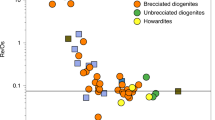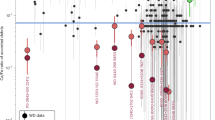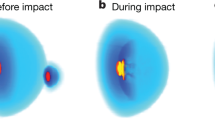Abstract
Rapid cooling of planetesimal cores has been inferred for several iron meteorite parent bodies on the basis of metallographic cooling rates, and linked to the loss of their insulating mantles during impacts. However, the timing of these disruptive events is poorly constrained. Here, we used the short-lived 107Pd–107Ag decay system to date rapid core cooling by determining Pd–Ag ages for iron meteorites. We show that closure times for the iron meteorites equate to cooling in the time frame ~7.8–11.7 Myr after calcium–aluminium-rich inclusion formation, and that they indicate that an energetic inner Solar System persisted at this time. This probably results from the dissipation of gas in the protoplanetary disk, after which the damping effect of gas drag ceases. An early giant planet instability between 5 and 14 Myr after calcium–aluminium-rich inclusion formation could have reinforced this effect. This correlates well with the timing of impacts recorded by the Pd–Ag system for iron meteorites.
This is a preview of subscription content, access via your institution
Access options
Access Nature and 54 other Nature Portfolio journals
Get Nature+, our best-value online-access subscription
$29.99 / 30 days
cancel any time
Subscribe to this journal
Receive 12 digital issues and online access to articles
$119.00 per year
only $9.92 per issue
Buy this article
- Purchase on Springer Link
- Instant access to full article PDF
Prices may be subject to local taxes which are calculated during checkout


Similar content being viewed by others
Data availability
All data are available within this Article and its Supplementary Information, or available from the authors on request.
References
Kruijer, T. S., Burkhardt, C., Budde, G. & Kleine, T. Age of Jupiter inferred from the distinct genetics and formation times of meteorites. Proc. Natl. Acad. Sci. USA 114, 6712–6716 (2017).
Tsiganis, K., Gomes, R., Morbidelli, A. & Levison, H. F. Origin of the orbital architecture of the giant planets of the Solar System. Nature 435, 459–461 (2005).
Walsh, K. J. & Morbidelli, A. The effect of an early planetesimal-driven migration of the giant planets on terrestrial planet formation. Astron. Astrophys. 526, A126 (2011).
Yang, J., Goldstein, J. I. & Scott, E. R. D. Iron meteorite evidence for early formation and catastrophic disruption of protoplanets. Nature 446, 888–891 (2007).
Goldstein, J. I., Scott, E. R. D. & Chabot, N. L. Iron meteorites: crystallization, thermal history, parent bodies, and origin. Geochemistry 69, 293–325 (2009).
Matthes, M., van Orman, J. A. & Kleine, T. Closure temperature of the Pd–Ag system and the crystallization and cooling history of IIIAB iron meteorites. Geochim. Cosmochim. Acta 285, 193–206 (2020).
Kelly, W. R. & Wasserburg, G. J. Evidence for the existence of 107Pd in the early Solar System. Geophys. Res. Lett. 5, 1079–1082 (1978).
Woodland, S. J. et al. Accurate measurement of silver isotopic compositions in geological materials including low Pd/Ag meteorites. Geochim. Cosmochim. Acta 69, 2153–2163 (2005).
Theis, K. J. et al. Palladium–silver chronology of IAB iron meteorites. Earth Planet. Sci. Lett. 361, 402–411 (2013).
Leya, I. & Masarik, J. Thermal neutron capture effects in radioactive and stable nuclide systems. Meteorit. Planet. Sci. 48, 665–685 (2013).
Matthes, M., Fischer-Gödde, M., Kruijer, T. S., Leya, I. & Kleine, T. Pd–Ag chronometry of iron meteorites: correction of neutron capture-effects and application to the cooling history of differentiated protoplanets. Geochim. Cosmochim. Acta 169, 45–62 (2015).
Matthes, M., Fischer-Gödde, M., Kruijer, T. S. & Kleine, T. Pd–Ag chronometry of IVA iron meteorites and the crystallization and cooling of a protoplanetary core. Geochim. Cosmochim. Acta 220, 82–95 (2018).
Schönbächler, M., Carlson, R. W., Horan, M. F., Mock, T. D. & Hauri, E. H. Silver isotope variations in chondrites: volatile depletion and the initial 107Pd abundance of the Solar System. Geochim. Cosmochim. Acta 72, 5330–5341 (2008).
Hunt, A. C. et al. Late metal–silicate separation on the IAB parent asteroid: constraints from combined W and Pt isotopes and thermal modelling. Earth Planet. Sci. Lett. 482, 490–500 (2018).
Hunt, A. C., Ek, M. & Schönbächler, M. Platinum isotopes in iron meteorites: galactic cosmic ray effects and nucleosynthetic homogeneity in the p-process isotope 190Pt and the other platinum isotopes. Geochim. Cosmochim. Acta 216, 82–95 (2017).
Kruijer, T. S. et al. Protracted core formation and rapid accretion of protoplanets. Science 344, 1150–1154 (2014).
Wasson, J. T. & Kallemeyn, G. W. The IAB iron-meteorite complex: a group, five sub-groups, numerous grouplets, closely related, mainly formed by crystal segregation in rapidly cooling melts. Geochim. Cosmochim. Acta 66, 2445–2473 (2002).
Benedix, G. K., McCoy, T. J., Keil, K. & Love, S. G. A petrologic study of the IAB iron meteorites: constraints on the formation of the IAB-winonaite parent body. Meteorit. Planet. Sci. 35, 1127–1141 (2000).
Hilton, C. D. & Walker, R. J. New implications for the origin of the IAB main group iron meteorites and the isotopic evolution of the noncarbonaceous (NC) reservoir. Earth Planet. Sci. Lett. 540, 116248 (2020).
Pravdivtseva, O., Meshik, A., Hohenberg, C. M. & Kurat, G. I–Xe ages of Campo del Cielo silicates as a record of the complex early history of the IAB parent body. Meteorit. Planet. Sci. 48, 2480–2490 (2013).
Schulz, T., Munker, C., Mezger, K. & Palme, H. Hf–W chronometry of primitive achondrites. Geochim. Cosmochim. Acta 74, 1706–1718 (2010).
Schulz, T., Münker, C., Palme, H. & Mezger, K. Hf–W chronometry of the IAB iron meteorite parent body. Earth Planet. Sci. Lett. 280, 185–193 (2009).
Kruijer, T. S., Kleine, T., Fischer-Gödde, M., Burkhardt, C. & Wieler, R. Nucleosynthetic W isotope anomalies and the Hf–W chronometry of Ca–Al-rich inclusions. Earth Planet. Sci. Lett. 403, 317–327 (2014).
Kleine, T. et al. Hf–W thermochronometry: closure temperature and constraints on the accretion and cooling history of the H chondrite parent body. Earth Planet. Sci. Lett. 270, 106–118 (2008).
Worsham, E. A., Bermingham, K. R. & Walker, R. J. Characterizing cosmochemical materials with genetic affinities to the Earth: genetic and chronological diversity within the IAB iron meteorite complex. Earth Planet. Sci. Lett. 467, 157–166 (2017).
Lichtenberg, T., Golabek, G. J., Gerya, T. V. & Meyer, M. R. The effects of short-lived radionuclides and porosity on the early thermo-mechanical evolution of planetesimals. Icarus 274, 350–365 (2016).
Trinquier, A., Birck, J.-L. & Allègre, C. Widespread 54Cr heterogeneity in the inner Solar System. Astrophys. J. 655, 1179–1185 (2007).
Wasson, J. T. & Huber, H. Compositional trends among IID irons; their possible formation from the P-rich lower magma in a two-layer core. Geochim. Cosmochim. Acta 70, 6153–6167 (2006).
Spitzer, F., Burkhardt, C., Pape, J. & Kleine, T. Collisional mixing between inner and outer solar system planetesimals inferred from the Nedagolla iron meteorite. Meteorit. Planet. Sci. 57, 261–276 (2022).
Hellmann, J. L., Kruijer, T. S., Van Orman, J. A., Metzler, K. & Kleine, T. Hf–W chronology of ordinary chondrites. Geochim. Cosmochim. Acta 258, 290–309 (2019).
Davison, T. M., O’Brien, D. P., Ciesla, F. J. & Collins, G. S. The early impact histories of meteorite parent bodies. Meteorit. Planet. Sci. 48, 1894–1918 (2013).
Morbidelli, A., Lunine, J. I., O’Brien, D. P., Raymond, S. N. & Walsh, K. J. Building terrestrial planets. Annu. Rev. Earth Planet. Sci. 40, 251–275 (2012).
Walsh, K. J. & Levison, H. F. Planetesimals to terrestrial planets: collisional evolution amidst a dissipating gas disk. Icarus 329, 88–100 (2019).
Haisch, K. E., Lada, E. A. & Lada, C. J. Disk frequencies and lifetimes in young clusters. Astrophys. J. Lett. 553, L153 (2001).
Ikoma, M., Nakazawa, K. & Emori, H. Formation of giant planets: dependences on core accretion rate and grain opacity. Astrophys. J. 537, 1013–1025 (2000).
Raymond, S. N. & Izidoro, A. Origin of water in the inner Solar System: planetesimals scattered inward during Jupiter and Saturn’s rapid gas accretion. Icarus 297, 134–148 (2017).
Johnson, B. C., Walsh, K. J., Minton, D. A., Krot, A. N. & Levison, H. F. Timing of the formation and migration of giant planets as constrained by CB chondrites. Sci. Adv. 2, e1601658 (2016).
Walsh, K. J., Morbidelli, A., Raymond, S. N., O’Brien, D. P. & Mandell, A. M. A low mass for Mars from Jupiter’s early gas-driven migration. Nature 475, 206–209 (2011).
Turrini, D., Magni, G. & Coradini, A. Probing the history of Solar System through the cratering records on Vesta and Ceres. Mon. Not. R. Astron. Soc. 413, 2439–2466 (2011).
Turrini, D., Coradini, A. & Magni, G. Jovian early bombardment: planetesimal erosion in the inner asteroid belt. Astrophys. J. 750, 8 (2012).
Gomes, R., Levison, H. F., Tsiganis, K. & Morbidelli, A. Origin of the cataclysmic Late Heavy Bombardment period of the terrestrial planets. Nature 435, 466–469 (2005).
Nesvorný, D., Vokrouhlický, D., Bottke, W. F. & Levison, H. F. Evidence for very early migration of the Solar System planets from the Patroclus–Menoetius binary Jupiter Trojan. Nat. Astron. 2, 878–882 (2018).
Brasser, R., Morbidelli, A., Gomes, R., Tsiganis, K. & Levison, H. F. Constructing the secular architecture of the Solar System II: the terrestrial planets. Astron. Astrophys. 507, 1053–1065 (2009).
Boehnke, P. & Harrison, T. M. Illusory Late Heavy Bombardments. Proc. Natl Acad. Sci. USA 113, 10802–10806 (2016).
Quarles, B. & Kaib, N. Instabilities in the early Solar System due to a self-gravitating disk. Astron. J. 157, 67 (2019).
Ribeiro, Rd. S. et al. Dynamical evidence for an early giant planet instability. Icarus 339, 113605 (2020).
Clement, M. S., Kaib, N. A., Raymond, S. N. & Walsh, K. J. Mars’ growth stunted by an early giant planet instability. Icarus 311, 340–356 (2018).
Clement, M. S., Kaib, N. A., Raymond, S. N., Chambers, J. E. & Walsh, K. J. The early instability scenario: terrestrial planet formation during the giant planet instability, and the effect of collisional fragmentation. Icarus 321, 778–790 (2019).
Liu, B., Raymond, S. N. & Jacobson, S. B. Early Solar System instability triggered by dispersal of the gaseous disk. Nature 604, 643–646 (2022).
Hunt, A. C., Ek, M. & Schönbächler, M. Separation of platinum from palladium and iridium in iron meteorites and accurate high-precision determination of platinum isotopes by multi-collector ICP-MS. Geostand. Geoanalytical Res. 41, 633–647 (2017).
Schönbächler, M., Carlson, R. W., Horan, M. F., Mock, T. D. & Hauri, E. H. High precision Ag isotope measurements in geologic materials by multiple-collector ICPMS: an evaluation of dry versus wet plasma. Int. J. Mass Spectrom. 261, 183–191 (2007).
Blichert-Toft, J., Moynier, F., Lee, C.-T. A., Telouk, P. & Albarède, F. The early formation of the IVA iron meteorite parent body. Earth Planet. Sci. Lett. 296, 469–480 (2010).
Chabot, N. L. Sulfur contents of the parental metallic cores of magmatic iron meteorites. Geochim. Cosmochim. Acta 68, 3607–3618 (2004).
Randich, E. & Goldstein, J. I. Cooling rates of seven hexahedrites. Geochim. Cosmochim. Acta 42, 221–233 (1978).
Ludwig, K. R. ISOPLOT 3.00. A Geochronological Toolkit for Microsoft Excel Special Publication 4 (Berkeley Geochronological Center, 2003).
Acknowledgements
This work was supported by the European Research Council under the European Union’s Seventh Framework Programme (FP7/2007–2013/ERC grant agreement 279779, M.S.). We gratefully acknowledge funding from STFC (ST/F002157/1 and ST/J001260/1, M.R.; ST/J001643/1, M.S.) and funding from the Swiss National Science Foundation (project 200020_179129, M.S.). A.C.H. wishes to thank M. Ek and M. Fehr for laboratory assistance at ETH Zürich during this study. M.S. would like to thank R. Carlson and M. Horan (DTM, Carnegie Institution) for their support and the opportunity to analyse Ag isotopes in May 2006. We also thank C. Smith and D. Cassey (Natural History Museum, London) and J. Hoskin (Smithsonian Institution National Museum of Natural History) for the loan of samples used in this work.
Author information
Authors and Affiliations
Contributions
M.S. designed the study. A.C.H., K.J.T. and M.S. prepared samples for isotope analyses and conducted the isotopic measurements. All authors were involved in the data interpretation and writing of the manuscript.
Corresponding author
Ethics declarations
Competing interests
The authors declare no competing interests.
Peer review
Peer review information
Nature Astronomy thanks James Van Orman and the other, anonymous, reviewer(s) for their contribution to the peer review of this work.
Additional information
Publisher’s note Springer Nature remains neutral with regard to jurisdictional claims in published maps and institutional affiliations.
Extended data
Extended Data Fig. 2 Isochron diagrams for a) IAB, b) IIAB, and c) IIIAB iron meteorites for the Pd–Ag system.
In each case, ε107Ag is plotted against 108Pd/109Ag for both GCR-corrected (filled symbols) and GCR-uncorrected data (unfilled symbols). Uncertainties on GCR-uncorrected data are 2 S.D. and within the size of the symbol (Table 1), while uncertainties for ε107Ag for GCR-corrected data represent the propagated 2 S.D. uncertainties of the GCR correction (Table 2). Isochrons are determined using GCR-corrected data and ISOPLOT55. *denotes GCR-corrected data from source11, shown for comparison but not included in the regressions.
Extended Data Fig. 3 IAB parent body evolution for both metal cooling times.
In both scenarios the parent body accreted relatively late at ~1.4 Myr and then underwent limited metal-silicate differentiation at ~6.0 Myr after CAI14. For metal cooling at ~12.8 Myr, the catastrophic impact event occurred in the timeframe ~11–13.6 Myr. This was followed by fast cooling and closure of the Pd–Ag system at ~12.8 +3.1/-4.6 Myr. For metal cooling at ~7.9 Myr after CAI the body was disrupted at about 6 Myr, while at or near its peak temperature. It then cooled quickly, leading to closure of the Pd–Ag system at 7.9 +1.0/-1.1 Myr.
Supplementary information
Supplementary Table 1
Summary of concentration and isotope data for Pd–Ag and Pt for IAB, IIAB and IIIAB iron meteorites.
Rights and permissions
About this article
Cite this article
Hunt, A.C., Theis, K.J., Rehkämper, M. et al. The dissipation of the solar nebula constrained by impacts and core cooling in planetesimals. Nat Astron 6, 812–818 (2022). https://doi.org/10.1038/s41550-022-01675-2
Received:
Accepted:
Published:
Issue Date:
DOI: https://doi.org/10.1038/s41550-022-01675-2



